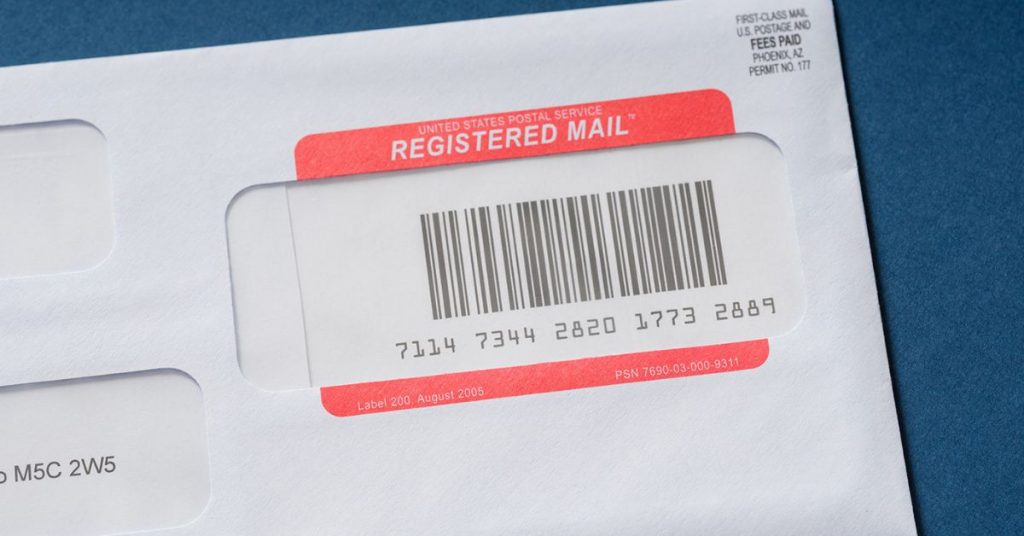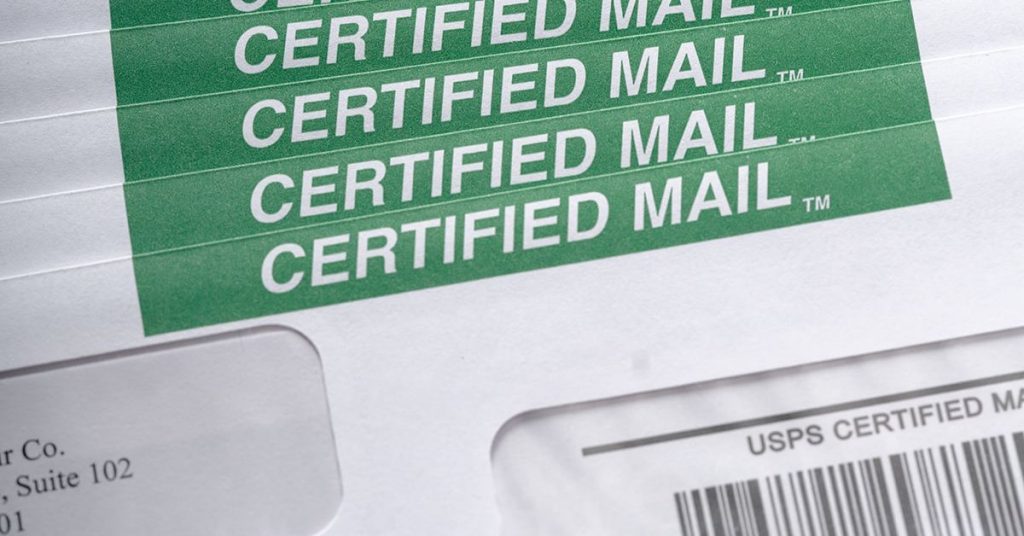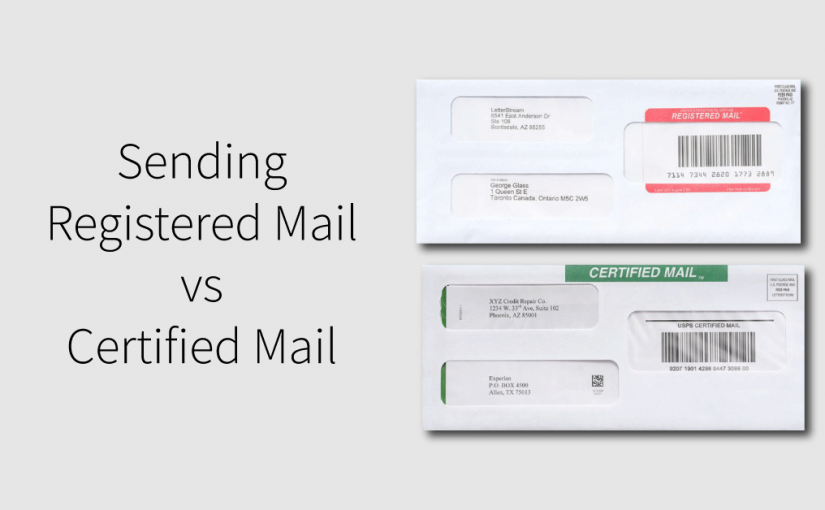We’re excited to announce that we recently launched the option to send Registered Mail from your online LetterStream account. Now we want to be upfront and clear with you when it comes to sending Registered Mail. This product is not for everyone. In fact, it’s not for most people but it is an option to use if you are required to send letters internationally and with tracking included. If that’s not something you need but you want to track your letters, that’s where Certified Mail comes into play and is a much better and cheaper option. Ok, now that we gave you that quick overview, let’s dive a little deeper into each one to compare USPS Registered Mail vs Certified Mail so you can make a more educated decision for yourself.
Registered Mail vs Certified Mail
Basically, what we just said was that when it comes to mailing important documents, there are two options to securing your mailings using tracking and confirmation of delivery. These options include the United States Postal Service Certified Mail and USPS Registered Mail.
However, there are very key differences between Certified vs Registered Mail and we’re here to help you choose the best fit for your specific needs.
Ok, let’s start with the basics. What is Registered Mail vs what is Certified Mail?
What is Registered Mail?

According to the United States Postal Service, USPS Registered Mail is “the most secure mail service” that they offer. It offers the highest level of security, tracking, and accountability for valuable and sensitive items or information that has to make it to a specific place. You can also send Registered Mail internationally.
Registered Mail tracking is supposed to happen at every stage of the process, providing a secure chain from sender to recipient. It’s supposed to include when it goes from person to person at the post office, to tracking when it is sent off to its destination. It is then tracked when it arrives at the next post office location and then its arrival at the required destination.
The Reality of Sending Registered Mail
Because we like to be transparent with our customers and about our product offerings, it’s important for us to tell you some of the realities about sending a letter as Registered Mail.
LetterStream does not send Registered Mail domestically (within the US) and that’s where Certified Mail comes into play, but more on that later. We currently only send to international addresses.
Like we mentioned above, Registered Mail tracking is included but it’s really important to know that updated and accurate tracking details are NOT guaranteed. It’s a bummer and we wish it were different but unfortunately, once the letter lands in the destination country, a new courier is responsible for delivery. Because of that they may or may not follow the proper protocols and that is beyond our control. This can also cause a delay in the timeframe of which the letter can believed. And it can sometimes take a really long time…like weeks. Unfortunately, there is one other catch, the signature confirmation is also NOT guaranteed, which is very important to be aware of. Sorry to be the bearer of bad news here but it’s just the reality.
What is Certified Mail?

Ok so let’s talk about Certified Mail, a product that is a bit more promising for customers.
USPS Certified Mail is a service offered by the United States Postal Service (USPS) that provides a higher level of assurance over First-Class Mail for senders.
Certified Mail offers a mailing receipt that provides proof that the item was mailed, along with verification upon delivery. With Certified Mail you also have the option to add on a Return Receipt, also known as a green card, or an Electronic Return Receipt (ERR), which is where you get a returned signature confirmation sent to you electronically.
Certified Mail is sent only within the US but it is way more reliable than Registered Mail. That’s not to say Certified Mail is a perfect service either when it comes to the USPS delivery of it. We can guarantee your bulk mailings will go out perfectly but once it goes to the post office that part is out of our hands. Sometimes the letters may take a little longer to be delivered than what was anticipated but overall Certified Mail is a reliable service to use.
Understanding the distinction between Registered Mail and Certified Mail is crucial for effective mail handling. At first glance it may seem like Registered Mail and Certified Mail are essentially the same and to be honest you’re not fully wrong.
Security Levels
Registered Mail is supposed to be like having an armored transport for your mail. provides maximum security, making it ideal for highly sensitive or valuable documents. While going through the postal service in the US, Registered Mail pieces are not left unattended and for added security, they are stamped with a seal to showcase that the letter has not been tampered with. Again, once it leaves the country and ends up in another, the guarantee of security is no longer there.
On the other hand, Certified Mail offers a standard level of security, suitable for important but less sensitive materials. The process documents when it is mailed and then delivered. For an added fee you can get a signature confirmation in the form of a Return Receipt or Electronic Return Receipt.
Proof of Mailing and Delivery
Like we just mentioned, Certified Mail offers a simple receipt as proof of mailing and delivery confirmation along with an electronic signature confirmation for an add-on. Registered Mail, can take it up a notch with step-by-step documentation that includes postal workers’ signatures throughout and then also a return receipt that includes the recipient’s signature, providing concrete proof of delivery. Just again a reminder, this is not guaranteed.
Tracking Abilities
While both services offer tracking, Registered Mail is supposed to provide more detailed tracking information. Certified Mail tracking technically is not as in-depth (although with the reality of Registered Mail, it actually can be), but we do have an in-depth explanation of it on our blog, here.
Here’s something fun to keep in mind. If you use our website to send letters then you can get Certfied Mail tracking and Registered Mail tracking updates instantly in your online portal whenever updates are made without ever having to type in the tracking number. Pretty cool isn’t it?
Cost of Registered Mail vs Certified Mail
To put it simply, the cost to send Registered Mail is more expensive than Certified Mail, especially when the international fees are included. Again, because we like transparency, sending a Registered letter through us starts at $30 a letter and can go up from there.
Certified Mail, is a more standard service and is definitely more affordable. Our prices start at $7.34 each.
Timeframe of Delivery
Certified Mail is typically faster than Registered Mail. Certified Mail takes about the same amount of time as First-Class Mail to be delivered, which on average is about four days. Now keep in mind, that that could change. Read more about that here.
Registered Mail, however, can take about 15 days to be delivered and sometimes it can take anywhere from 6-8 weeks depending on where it is going.
To Sum It Up
All-in-all, when choosing between Registered Mail vs. Certified Mail, it really all comes down to your needs, requirements and what works best for you. LetterStream now offers both options to cater to your specific mailing needs. Our services are tailored to ensure your important documents are printed and mailed out on time and with complete security included on our end each and every time.
To send a Certified letter click here. To send a Registered letter click here.
Please note: We don’t recommend using Registered Mail unless you’re required to do so. Tracking, signature, and delivery are not guaranteed. Delivery can take 3-6 weeks, or more, depending on destination country. All of your addresses must be international (outside of the US) and include the country. We cannot send more than 15 sheets of paper.

